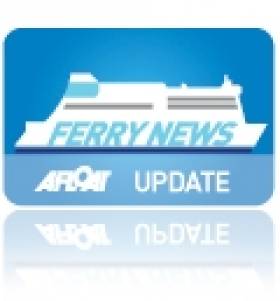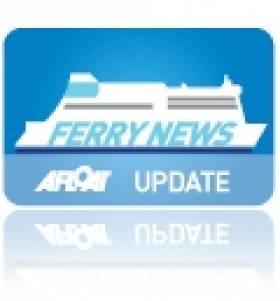Displaying items by tag: Celtic Horizon
Wexford Welcomes New Irish-French Ferry Celtic Horizon
The changeover of vessels coincides with the existing Rosslare-Cherbourg sailing schedule of three round-trips per week, noting there are no sailings from the Wexford port on Mondays. Celtic Horizon is due to be introduced with her maiden 'Irish' voyage on Tuesday night, departing Rosslare at 21.30hrs. On the following Monday she is to be officially launched onto the service.
Celtic Horizon will boost capacity on the French route, offering a wider choice of restaurants, bars and a children's play-room. She can carry 840 passengers, 200 cars and 120 freight vehicles. The 186m ferry is from a ro-pax series (including Norman Voyager) designed and built by Cantiere Navala Visentini based in Portoviro, outside Venice.
During her five-day repositioning route from the Mediterranean, Celtic Horizon made an en-route call to Gibralter, anchoring off the British colony on Thursday. Another of the same Visentini ro-pax class vessels, Cartour Epilson is believed to have taken over Celtic Horizon, formerly named Cartour Beta when she served her last season between Termini Imerese in Sicily to Salerno while on charter to C&T.
CLF will be the only ferry operator running services to France, between 2 January -19 February 2012, as Irish Ferries, which also operates on the Rosslare-Cherbourg route, will be taking off Oscar Wilde for annual dry-docking. For schedules click HERE.
In addition there will be no sailings between Cork-Roscoff, as Brittany Ferries final sailing for this year is 29 October, served by 'flagship' Pont-Aven. The 2012 season starts in late March.
New Celtic Link Ferry on Re-Positioning Voyage off Africa
CLF are to charter Celtic Horizon for a five-years and the 25-knot capable vessel will takeover the existing thrice-weekly round trip sailing schedule from ro-pax Norman Voyager. Between 2 January -19 February 2012, CLF will be the only continental ferry operator running services as rivals Irish Ferries will be taking their cruiseferry Oscar Wilde for annual dry-docking. To read more click HERE.
In addition there will be no sailings between Cork-Roscoff, as operators Brittany Ferries last sailing for this year is 29 October, served by 'flagship' Pont-Aven. The 2012 season starts in late March.
Celtic Horizon is the first vessel to be named with a 'Celtic' prefix of part of their ferry operations, since the company brought European Diplomat from former route operators P&O (Irish Sea) in 2005. The freight-ferry renamed Diplomat, served Celtic Link Ferries until 2009. Since then she has been on charter in the Caribbean until this summer when she was sold to the breakers in Alang, India. To read more click HERE.
As for Celtic Horizon, she was built in 2006 and spent her last season this year as Cartour Beta while on charter to C&T's routes between Naples and Sicily, to read more click HERE. The 186m ro-pax is believed to be heading for Gibraltar while en-route to Rosslare.
During her Irish service, she will maintain Italian registry of Bari whereas her predecessor Norman Voyager changes flags from the UK to that of the French tricolour. Both vessels are similar as they share a ro-pax design which has proved popular for Italian shipbuilders Cantieri Navali Visentini.
The 2008 built Norman Voyager of 26,904grt is to revert to LD Lines operation and used on their 'Motorways of the Seas' St. Nazaire-Gijon service, though she was to enter on the Marseilles-Tunis route. Her new role on the Franco-Iberian route sees the replacement of Norman Asturias.































































